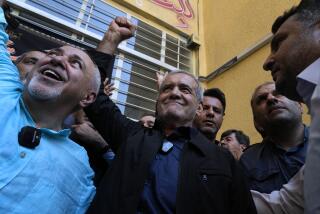Southern California’s Iranian diaspora watches protests from the edge of their seats
- Share via
Samira Damavandi was visiting her family in Palos Verdes when protesters began marching through the streets of Iran demanding economic and social change.
Curious about what sparked the outbursts, she looked to social media, and her mother, for answers. As Damavandi scrolled through Persian-language feeds on Twitter and Telegram, her mom put the revolt in down-to-earth terms: The price of eggs and other basic foods had doubled — in some cases, tripled — throughout the country.
Like many in Southern California’s large Iranian expatriate community, the 24-year-old has less in common with those demonstrating in Iran today than with people who supported the 2009 protests known as the Green Movement. Those demonstrations were largely driven by educated, middle-class Iranians, many of whom had relatives in the U.S. The latest unrest has largely drawn out poorer workers who some experts say are less likely to have ties abroad.
Young, working-class and fed up: Iran’s deadly protests driven by a new crop of dissenters »
But that hasn’t quelled her desire for information — Iranian Americans throughout the diaspora are glued to their phones and TVs, hungry for updates.
“We have family in Iran, and my mom’s cousins all live there,” said Damavandi, who recently moved to Washington, D.C. “We have been talking to our cousins on Telegram” — a popular messaging app — “and checking in with them.”
She also has been in constant contact with friends currently on vacation in Iran. Neither they nor her relatives have participated in the protests, she said, but one friend described rowdy crowds in front of the University of Tehran.
“They all said, ‘No, I don’t know anyone protesting,’” Damavandi said.
The protests began Dec. 28 in Mashhad, Iran’s second-largest city, and spread quickly to more than 30 other cities, showing the deep frustration among working-class Iranians coping with high unemployment, rising prices and official corruption.
“One major difference is that in 2009, the working class was not as active. There was almost no demand for economic change,” said Misagh Parsa, a sociology professor at Dartmouth College and author of “Democracy in Iran: Why It Failed and How It Might Succeed.” “But many of the slogans from 2009 that are radical showed up again, like ‘Death to the dictator.’”
The working class faces “extreme” inequality because of sanctions and corruption, Parsa said.
“A new budget came out that shows clerics using money on the clerical establishment and less on universities and colleges, while demanding more taxes,” he said. “The poor would have to pay more.”
Peyman Malaz has kept in touch with his loved ones by phone and email. He has noticed that where people once felt shy about critiquing the government, they now openly share their views.
Malaz, who moved to Los Angeles 15 years ago, sees the protests in his home country as an extension of the Green Movement.
“What people are chanting in the streets is the same as during the Green Movement but more radicalized,” said Malaz, 32. “The people of Iran gave a chance for reform, they participated in two elections, but they don’t see any fundamental changes.”
Most of Malaz’s family lives in Tehran and Esfahan. They haven’t joined the protests, he said, but he found out through social media that some of his friends have.
“I haven’t talked to them yet,” he said. “I didn’t want to put them in danger by talking to them about it.”
He has mixed feelings about the uprising. Malaz said he supports a change in government in Iran, but worries about what that would mean for Iran’s national security in the current political climate.
“It makes me upset to see that people are shot in the street,” said Malaz, manager of the Pars Equality Center, a nonprofit organization that helps Iranians integrate into American society. “At the same time I feel proud that even though people know the consequences of their actions — they have seen the brutality of the regime in Iran — they still risk everything.”
At his Persian rug store in Westwood, Alex Helmi pondered the outcome of the unrest. He said he hopes that it will bring about change for the working class “so they can at least take food home,” though he isn’t sure whether it will happen.
“The working class are under such economic pressure that they don’t have the ability to buy things for basic life,” he said.
The 61-year-old said he supports the people’s right to protest, but he cautioned against setting fires and destroying cars. If the protesters are violent, Helmi said, the police will respond in kind.
“I speak with my family in Iran, and they say young people are unhappy,” Helmi said. “A very select few make a lot of money. It’s not fair.”
Each year, the Iranian public’s purchasing power dwindles, he added. The price of goods skyrockets while wages are stagnant. Some have a hard time affording bread.
“There has to be change in Iran,” he said.
ALSO
After days of unrest in Iran, pro-government demonstrators take to the streets
Iran is seeing the biggest antigovernment protests in years. What’s driving the unrest?
Iran’s supreme leader blames foreign ‘enemies’ for protests as death toll rises to 21
For more California news follow me on Twitter: @sarahparvini
More to Read
Sign up for Essential California
The most important California stories and recommendations in your inbox every morning.
You may occasionally receive promotional content from the Los Angeles Times.











